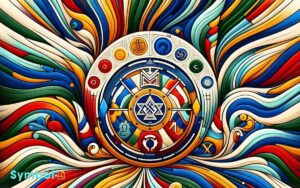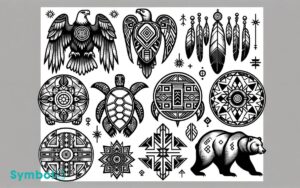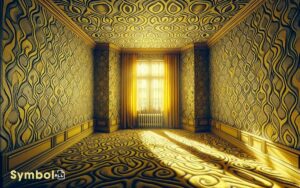What Does the Color Tan Symbolize? Stability & Reliability!
Tan isn’t simply a color; it’s a symbol of your connection to the earth and a marker of stability and trust. This hue represents the grounding and cyclicality of life, embodying growth and resilience.
In design, it offers a calming stability, fostering a sense of security and tranquility. It signifies neutrality and adaptability, making spaces inviting and cozy.
Tan stands for elegance and sophistication in fashion, denoting high-quality materials and timeless appeal. It also holds psychological importance, evoking a sense of reliability and vitality.
The depth of tan’s symbolism enriches its universal appeal, revealing layers of meaning that connect across cultures and contexts.

Key Takeaway
Earthly Connections
Tan embodies the very essence of our planet, grounding its symbolism in the rich, fertile soil that sustains life.
This hue evokes a sense of connection to the earth, reminding you of humanity’s dependence on and relationship with the natural world. It’s not just about the physical presence of soil beneath our feet but also the cyclical nature of life and growth it represents.
In an academic analysis, tan’s representation goes beyond mere color psychology; it explores cultural and environmental significances. It prompts you to reflect on how societies have historically valued and interacted with the earth.
This color’s understated yet profound presence in various cultural artifacts and natural landscapes underscores its universal relevance, offering insights into human-nature relationships without uttering a single word.
Symbol of Stability
As you explore the color tan, you’ll find its grounding earthly connection offers a sense of stability that’s deeply rooted in nature. Its dependability in design transcends mere aesthetics, providing a solid foundation that evokes reliability and trust.
Additionally, tan’s calming presence indoors creates an ambiance of tranquility, further cementing its role as a symbol of stability.
Grounding Earthly Connection
Embracing the color tan invites a sense of grounding and stability, deeply connecting you to the earth’s inherent tranquility and strength.
This hue, reminiscent of soil, sand, and stone, symbolizes an unshakeable connection to the natural world. It evokes a feeling of being rooted, suggesting a foundation that’s both dependable and enduring.
In an analytical sense, tan’s association with the earth goes beyond mere color psychology; it reflects a universal yearning for a solid base in an ever-changing world.
This connection fosters a sense of belonging, anchoring you in the present moment and offering a platform for growth.
Ultimately, tan’s symbolism speaks to a deeper, instinctual need for stability through a tangible bond with our natural environment.
Dependability in Design
In design, the color tan is widely recognized as a symbol of stability, offering a dependable backdrop that enhances the overall sense of security and reliability in a space.
This hue embodies a subtle strength, quietly asserting itself as a foundation upon which other elements can confidently rely.
Its inherent neutrality serves not just as a visual anchor but also as a significant one, conveying a sense of permanence and trustworthiness that’s essential in environments where consistency is key.
By integrating tan into a design palette, you’re not merely selecting a color; you’re invoking an ethos of dependability.
It’s this strategic use of tan that underpins its value, transforming spaces into bastions of calm assurance without the need for overt declarations of strength.
Calming Presence Indoors
Tan’s soothing hue casts a serene ambiance within interiors, serving as a steadfast symbol of stability that quietly anchors a room’s aesthetic and emotional balance.
When you introduce tan into your living space, you’re not just selecting a color; you’re infusing your environment with a calming presence that transcends mere visual pleasure. This color, emblematic of the earth’s grounding nature, fosters a sense of security and continuity.
Its subtlety promotes a harmonious blending with other elements, avoiding any clash while enhancing the overall cohesion of the space.
Additionally, tan’s versatility allows it to adapt, supporting both minimalist and richly textured designs.
It’s this adaptive quality that enables tan to maintain its role as a tranquil backdrop, encouraging a focused, calm, and collected atmosphere conducive to both rest and productivity.
Neutrality in Design
The use of tan in design often signifies an intentional choice to invoke a sense of neutrality and balance.
This color acts as a grounding force, providing a backdrop that allows other elements to stand out without overwhelming the senses.
In an academic analysis, it’s essential to understand that tan’s neutrality doesn’t equate to a lack of character.
Instead, it offers a sophisticated canvas that accommodates a wide array of design elements, enabling a harmonious blend of colors and textures.
It’s this inherent versatility that makes tan an invaluable tool in the designer’s palette, facilitating an environment that supports a variety of aesthetic and functional intentions.
Tan’s role in design transcends mere background color, embodying a foundational principle of balance and adaptability.
Approachability and Warmth
As you explore the symbolism of tan, you’ll find its hues inherently contribute to creating inviting social environments.
This color’s soft, understated presence fosters a perception of cozy comfort, encouraging openness and interaction.
Its application in design, thus, not only enhances aesthetic appeal but also subtly influences social dynamics.
Inviting Social Environments
Many people find that incorporating the color tan into social spaces greatly enhances the area’s approachability and warmth, fostering more inviting environments.
This hue, emblematic of stability and reliability, subtly encourages open communication and ease of interaction among individuals.
In the domain of social psychology, colors greatly influence human perception and behavior. Tan, with its natural, earthy essence, resonates on a frequency that promotes comfort and a sense of belonging.
It’s not merely a color; it’s a conduit for creating a more harmonious and welcoming atmosphere.
When you choose tan for your social environments, you’re not just making a design choice; you’re strategically crafting spaces that naturally draw people together, encouraging dialogue and shared experiences without uttering a single word.
Cozy Comfort Perception
Incorporating the color tan into living spaces greatly enhances perceptions of coziness and warmth, making these areas more approachable and inviting.
This hue, with its natural earth tones, inherently suggests a sense of security and stability, crucial for creating an environment where one feels at ease and welcomed.
Consider the following ways tan influences our perception:
- Visual Comfort: Tan’s soft hue minimizes visual strain, allowing for a relaxed atmosphere.
- Psychological Warmth: It evokes warmth, akin to the feeling of being enveloped in a warm embrace, promoting interpersonal connections.
- Flexibility in Design: Tan’s versatility complements various decor styles, enhancing the overall sense of comfort through seamless integration.
Thus, tan’s ability to foster cozy comfort isn’t just an artistic choice but a strategic approach to crafting spaces that resonate with approachability and warmth.
Practicality and Simplicity
Reflecting on the color tan, you’ll find it epitomizes practicality and simplicity, serving as a visual foundation that easily integrates into various design contexts. Its unassuming presence doesn’t demand attention, yet it provides a stable backdrop that enhances other elements.
Tan’s simplicity lies in its naturalness, reminiscent of earth and sand, which inherently suggests a return to basics and uncomplicated living. This color doesn’t vie for the spotlight but supports a philosophy of minimalism and functionality.
In an era where the world is saturated with complexity and excess, tan’s practicality offers a revitalizing pause. It encourages a focus on what’s essential, stripping away the unnecessary and celebrating the beauty of simplicity.
Tan, hence, isn’t just a color; it’s a demonstration of the enduring value of practicality in our lives.
Elegance in Fashion
Building on its foundation of practicality and simplicity, the color tan also brings an understated elegance to the fashion industry, elevating everyday wear with its timeless appeal.
This hue’s versatility allows it to serve as a neutral backdrop, enabling designers to craft pieces that are both sophisticated and accessible.
When you incorporate tan into your wardrobe, you’re tapping into:
- A palette of natural harmony, blending seamlessly with a wide range of colors for effortlessly chic ensembles.
- A sense of sophistication, where its subtlety communicates a refined taste without the need for bold statements.
- An association with high-quality materials, such as leather and suede, that inherently carry an air of luxury and durability.
In essence, tan embodies an elegant simplicity, making it a perennial favorite in fashion circles for its ability to enhance the wearer’s natural style without overwhelming it.
Psychological Effects
Frequently, the color tan exerts a subtle yet profound psychological impact, shaping perceptions and emotions without one’s conscious awareness.
This earthy hue often evokes a sense of stability and reliability, providing a grounding effect that can reduce feelings of anxiety.
When you’re surrounded by tan, you might find yourself feeling more centered and calm, as it mimics the natural world’s serene and unchanging aspects.
Additionally, tan’s inherent neutrality offers a backdrop that encourages open-mindedness and adaptability, subtly influencing you to be more receptive to new ideas.
It’s a color that doesn’t overwhelm but instead, facilitates a mental state conducive to productivity and creativity.
Understanding tan’s psychological effects allows you to harness its potential in environments where calmness, stability, and openness are desired.
Cultural Interpretations
While the psychological effects of tan offer a glimpse into its calming nature, its cultural interpretations reveal a rich tapestry of meanings that span across time and geography.
You’ll find that:
- In many Western societies, tan is often associated with health, vitality, and the leisure of outdoor activities, reflecting a societal admiration for an active lifestyle.
- In some Eastern cultures, tan can symbolize the earth, stability, and humility, grounded in the reverence for nature and agricultural life that shapes daily existence and philosophical outlooks.
- Among indigenous peoples, particularly those in arid or desert regions, tan embodies the resilience, adaptation, and harmony with the land, echoing their respect for and symbiosis with the natural world.
These interpretations offer you a lens to appreciate how a single color can hold diverse, profound significances across cultures, illuminating the complexity of human symbolism. These varied perspectives reveal how a single hue can serve as a powerful medium for storytelling, tradition, and emotion in different societies. For instance, the meaning of red in China is deeply intertwined with notions of prosperity, joy, and celebration, often seen in festivals and weddings. Such cultural insights remind us that colors are not merely visual elements but rich carriers of collective identity and heritage.
Versatility in Use
You’ll find that the color tan exhibits remarkable versatility, functioning as a cornerstone in both fashion and interior design due to its harmonizing capabilities.
Its role as a neutral palette foundation allows for endless creativity, serving as a backdrop that accentuates other colors and textures.
Additionally, tan’s adaptability across various styles underscores its universal appeal and enduring relevance in aesthetic expressions.
Fashion and Interior Harmony
In both fashion and interior design, the color tan exhibits unparalleled versatility, harmonizing with a wide array of colors and themes to create aesthetically pleasing environments.
When you integrate tan into either domain, you leverage its subtle elegance to achieve balance and warmth.
This color’s adaptability can be attributed to several factors:
- Compatibility: Tan pairs seamlessly with both vibrant and muted tones, enhancing visual depth without overpowering.
- Timelessness: Unlike more transient color trends, tan remains perpetually in vogue, providing a stable foundation for evolving styles.
- Psychological Comfort: Its natural earthiness evokes a sense of calm and stability, making spaces feel more inviting and garments more approachable.
Understanding these attributes allows you to skillfully incorporate tan, maximizing its potential to enrich and harmonize aesthetic compositions.
Neutral Palette Foundation
Building on its role in fashion and interior design, the color tan serves as a foundational element in a neutral palette, offering unparalleled versatility across various applications.
This hue’s inherent neutrality means it can seamlessly integrate with a wide range of colors, enhancing their visual appeal without overpowering them.
Its subtle warmth brings a sense of calm and sophistication, making it a preferred choice for creating serene and inviting spaces.
Additionally, tan’s adaptability extends beyond aesthetics; it also plays an essential role in the psychological perception of environments. It evokes feelings of stability and reliability, making it an ideal backdrop for spaces designed to foster comfort and trust.
Hence, tan’s versatility in use isn’t merely a matter of fashion or trend but is deeply rooted in its ability to harmonize with both the visual and emotional components of design.
Adaptability Across Styles
Harnessing its intrinsic neutrality, tan proves incredibly versatile, effortlessly adapting to a myriad of styles from minimalist to baroque, without compromising the distinct aesthetics of each.
This adaptability is key to its widespread popularity in design and fashion, where it serves multiple functions:
- Enhancing Texture and Depth: In minimalist settings, tan highlights the purity of form and texture, bringing warmth and depth that might otherwise be lacking.
- Balancing Complexity: In more ornate or baroque environments, it acts as a grounding force, preventing visual clutter by balancing intricate designs with its calming presence.
- Intermediary Element: Tan serves as a bridge between contrasting colors, ensuring a harmonious palette that allows for fluid transitions between different design elements.
This versatility not only showcases tan’s adaptability but also its critical role in achieving aesthetic coherence across diverse styles.
Association With Materials
Throughout history, materials such as clay, sand, and leather have naturally exhibited a tan color, profoundly influencing human perception and use of these resources.
This association isn’t merely superficial; it’s deeply rooted in the practical and symbolic significance these materials hold.
Clay, for instance, signifies foundation and versatility, mirroring tan’s adaptability in various applications.
Sand, on the other hand, evokes a sense of vastness and timelessness, qualities that tan embodies through its enduring presence in fashion and design.
Leather, celebrated for its durability and elegance, aligns with tan’s sophistication and resilience.
These connections aren’t accidental but are reflections of how human culture and the natural world intertwine, attributing layers of meaning to the color tan through its association with these elemental materials.
Influence on Mood
The color tan greatly shapes our emotional landscape, subtly influencing feelings of calmness and stability in our environments.
This natural hue, reminiscent of earth and sand, fosters a sense of grounding and reliability. When you surround yourself with tan, you’re likely to experience:
- A Boost in Calmness: Tan’s earthy essence can notably reduce feelings of anxiety, promoting a tranquil and serene atmosphere.
- Enhanced Concentration: Its neutral quality doesn’t overstimulate, making it easier for you to focus and remain productive.
- Increased Feelings of Stability: Tan symbolizes solidity and dependability, qualities that can make you feel more secure and confident.
Understanding tan’s impact on mood is essential for creating spaces that nurture well-being and foster a balanced emotional state.
Future Trends in Tan
As we look toward the future, it’s clear that tan will continue to play a pivotal role in design and fashion, evolving in ways that reflect broader societal trends and values.
Tan’s versatility and neutrality will likely allow it to adapt seamlessly into future aesthetic movements, which could emphasize sustainability and minimalism.
The color’s inherent connection to the natural world suggests it will become increasingly significant as eco-consciousness rises.
Additionally, as digital platforms influence color trends at an accelerated pace, tan’s ability to provide a calming, understated background may become more valued.
Its psychological effect of stability and reliability could resonate deeply in an era marked by rapid change, making tan a color that not only adapts but thrives, embodying a bridge between tradition and innovation.
Conclusion
In sum, tan isn’t just a hue; it’s a narrative. It weaves a tale of earthiness, stability, and versatility, embodying practical simplicity while offering a canvas of neutrality.
This color invites warmth, suggesting an approachable aura, and its association with materials grounds it in tactile reality. As you embrace tan, you’re not just choosing a color; you’re embracing a philosophy of balance and understated elegance.
With trends ever-evolving, tan stands resilient, proving that true style is timeless.






